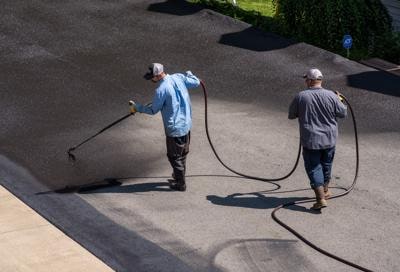Boost Security and Allure: Angled Parking Lot Solutions with Asphalt Sealing
Boost Security and Allure: Angled Parking Lot Solutions with Asphalt Sealing
Blog Article
Hot Mix Asphalt: A Lasting Service for Sidewalk
Warm Mix Asphalt (HMA) has actually arised as a leading lasting option for sidewalk options, offering a myriad of ingenious modern technologies and ecological benefits. As the demand for environmentally friendly building practices grows, discovering the nuances of HMA's sustainability can provide beneficial understandings right into the future of sidewalk services.
Ecological Advantages of Hot Mix Asphalt

In Addition, Warm Mix Asphalt assists to alleviate metropolitan warmth island results. Its dark color soaks up sunlight, reducing the quantity of warmth mirrored back into the environment compared to lighter-colored pavements. This can decrease ambient temperature levels in metropolitan areas, reducing the need for air conditioning and eventually reducing energy intake.
In enhancement, Hot Mix Asphalt adds to enhanced stormwater monitoring. Its permeable nature allows water to reenergize and penetrate the sidewalk groundwater supplies, lowering runoff and the risk of flooding. These environmental benefits make Hot Mix Asphalt a sustainable choice for leading highways and roadways.
Power Effectiveness in HMA Production
Is power performance an essential variable in the production of Hot Mix Asphalt (HMA)? Energy plays a considerable function in the production of HMA, influencing both expense and environmental sustainability. One key aspect of power effectiveness in HMA production is the usage of cozy mix asphalt (WMA) technologies.
In addition, developments in plant innovations have led to more energy-efficient HMA manufacturing procedures. By enhancing power use in HMA production, the market can lower its carbon impact while preserving high-quality pavement products.
Recyclability of Hot Mix Asphalt
The recyclability of Warm Mix Asphalt (HMA) is a pivotal facet of its sustainability and long-term environmental effect. HMA is among the most recycled products in the USA, with over 100 million lots of redeemed asphalt sidewalk (RAP) being recycled yearly in new sidewalk building and construction. Reusing HMA offers a number of ecological advantages, such as reducing the need for virgin materials, reducing energy intake throughout production, and decreasing the amount of waste sent out to land fills.
The process of recycling HMA involves grating the existing pavement, crushing it into smaller pieces, and mixing it with brand-new aggregate and asphalt binder to create a recycled mix. This recycled mix can commonly do along with or perhaps better than standard HMA, while calling for less resources and generating reduced greenhouse gas discharges. By including RAP right into brand-new sidewalk jobs, road firms can save natural sources, lower prices, and minimize the environmental impact of roadway construction and upkeep tasks. Generally, the recyclability of HMA plays a considerable function in promoting sustainable techniques within the sidewalk market.

Long-Term Performance of HMA
Asphalt pavements demonstrate longevity and resilience over a prolonged period, showing the lasting performance of Warm Mix Asphalt (HMA) The longevity of HMA can be credited to its ability to endure rush hour tons, rough weather condition conditions, and the impacts of aging. Studies have shown that well-designed and correctly created HMA pavements can last for twenty years or more with regular upkeep. The secret to optimizing the lasting efficiency of HMA hinges on utilizing high-grade materials, adhering to ideal techniques in building, and carrying out efficient maintenance techniques. Proper drainage, regular assessments, and timely repairs are important for preserving the architectural stability of HMA pavements with time. Furthermore, advancements in HMA modern technology, such as making use of polymer-modified binders and warm mix asphalt, have actually additionally improved the longevity and long life of HMA pavements. By focusing on high quality construction and upkeep practices, HMA remains to verify itself as a sustainable and cost-efficient option for durable sidewalk infrastructure.

HMA: Resilience and Sustainability
Demonstrating both durability and sustainability, Warm Mix Asphalt (HMA) has come to be a foundation in the building and construction of durable pavement frameworks - hot mix asphalt. HMA's longevity comes from its capacity to Get the facts endure heavy lots, harsh climate conditions, and high website traffic volumes, making it a reputable option for highways, highways, and airport terminal runways. The structure of HMA, which commonly consists of aggregates, binder, and filler, plays a critical role in boosting its long life and resistance to use and tear
In addition, HMA's sustainability exists in its recyclability and energy-efficient manufacturing process. The capability to recycle reclaimed asphalt Check This Out pavement (RAP) in new HMA blends reduces the demand for virgin materials and lessens the ecological impact of pavement construction and upkeep. In addition, the power efficiency of creating HMA depends on its reduced mixing temperatures contrasted to various other sidewalk products, bring about reduced energy intake and greenhouse gas emissions.
Verdict
In verdict, warm mix asphalt her response (HMA) supplies a lasting option for sidewalk with its ecologically friendly characteristics. HMA's recyclability, power effectiveness in production, and long-term resilience make it an environment-friendly option for road building and construction.
HMA is one of the most recycled materials in the United States, with over 100 million loads of recovered asphalt pavement (RAP) being reused annually in new sidewalk building.The procedure of recycling HMA involves grating the existing pavement, squashing it into smaller sized pieces, and blending it with new accumulation and asphalt binder to produce a recycled mix.Asphalt sidewalks demonstrate durability and durability over a prolonged duration, showing the long-term performance of Warm Mix Asphalt (HMA) Furthermore, advancements in HMA technology, such as the usage of polymer-modified binders and warm mix asphalt, have actually further improved the resilience and long life of HMA sidewalks. The ability to recycle reclaimed asphalt pavement (RAP) in brand-new HMA mixtures minimizes the demand for virgin products and reduces the ecological influence of pavement building and upkeep.
Report this page